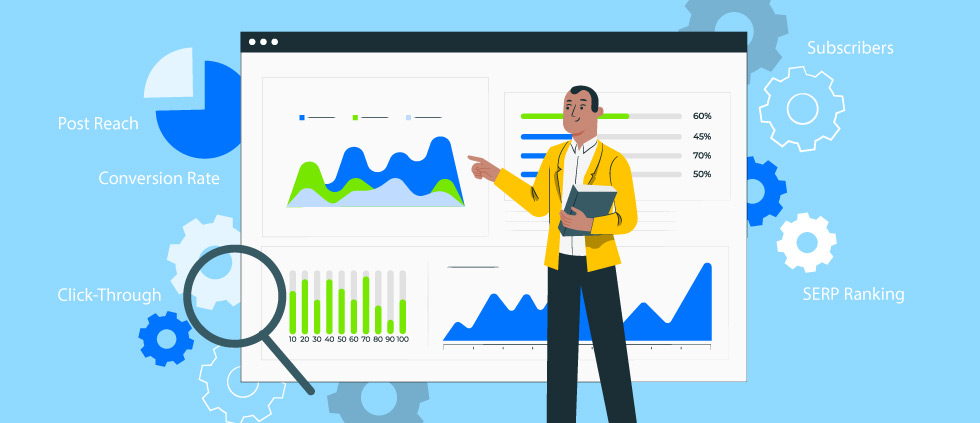How to Measure Your Healthcare Content Marketing Performance

The events over the past two years have shown us that healthcare consumers want timely, critical health information and accurate answers to their healthcare questions. Healthcare content marketing is a valuable way to reach current and prospective members and patients with accurate, relevant health information and helpful, educational content. Benefits for your brand include awareness, better patient and member health literacy, consumer engagement, better search engine rankings and recognition as a thought leader.
Healthcare content marketing is both an art and a science. It’s one thing to create great content in the form of blog posts, eBooks, infographics, podcasts, quizzes, videos and whitepapers, but how can you measure that content to see if it made an impact? Measuring your healthcare content marketing performance may seem challenging, but it doesn’t have to be.
1. Set content marketing goals relevant to your organization and its business objectives.
Identifying these goals will help you define a set of content marketing strategies, the types of content you create, the right metrics to track, and which KPIs you will measure against to achieve these goals. Examples of content marketing goals include:
- Increase brand awareness
- Inform and educate members and prospects
- Engage with members and prospects
- Drive more traffic to your website
- Generate more leads
- Improve existing member retention
2. Choose content marketing metrics as key performance indicators (KPIs) based on your goals.
Once you’ve identified your content marketing goals, it’s time to think about what valuable content marketing metrics to track. Refer to our previous blog post for examples of 40 metrics that can be used to measure your healthcare content marketing performance. If you’re not sure which metrics to track, we can help with that, too!
We recall some great advice from the Content Marketing Institute: “These days you can measure [almost] anything, but just because you can measure everything doesn’t mean that you should.” All KPIs are metrics, but not all metrics are key performance indicators (KPIs). Anything that you track but don’t report on is a metric. Metrics that are tracked and reported on weekly and monthly are your KPIs.
Content marketing KPIs measure content marketing strategies, statistics, and data over time, and marketers use them to analyze how well content is performing and assess progress. It’s important to choose KPIs that align with your content marketing goals. This article from the Content Marketing Institute has a great comprehensive list of KPIs to choose from.
Which KPIs go toward which goals? We put together a few examples of content marketing goals and some associated KPIs.
| Content marketing goals | Examples of content marketing KPIs |
|---|---|
| Increase brand awareness | Pageviews, website traffic sources, backlinks (referring sites), post reach, follower growth and growth rate |
| Inform and educate members and prospects | Social engagement, video views, website traffic, post reach |
| Engage with members and prospects | Subscribers, new vs. returning visitors, social engagement, email open rate, social amplification rate, video views |
| Drive more traffic to your website | Authority (SEO), organic traffic, website traffic sources, email click-through rate (CTR), page views, page views per visit |
| Generate more leads | Asset downloads, conversions tied to content, leads tied to content, renewals tied to content, webinar registration and attendance, keyword rankings, email conversion rate |
| Improve existing member retention | Email subscriber churn rate, opt-out rate, new vs. returning visitors, renewals tied to content |
These KPIs can help provide direct feedback on your content marketing efforts.
A few parting thoughts
- Remember that every content marketing strategy varies in its purpose, so you’ll want to start with your goals to understand which KPIs and metrics make sense.
- Content marketing takes time. We’re the first to admit that it’s a “slow burn.” This article from Advertising Week said it best: “Content marketing is not a silver bullet. It’s not a quick fix. It is not a vehicle for fast sales, and it’s not for the faint of heart. However, content marketing is the most sustainable way to grow demand and a loyal audience.”
- With so much data at your fingertips, make sure that you take it a step further by analyzing your results to help determine actionable insights. Doing so will address areas you need to improve or areas of opportunity to take your healthcare content marketing strategy to the next level.
- Keep your team, executive team and other stakeholders regularly informed about your content marketing performance. Keep it simple by developing a simple editorial status report to share key analytics and insights.
- Whether your healthcare marketing team is new to content marketing or if you’ve been doing content marketing for a long time, these tips for measuring your healthcare content marketing ROI can be applied.
When done right, content marketing can mean more visibility for your healthcare brand, more website traffic, more leads and then more patients or members. If you are looking for a partner to help you prioritize organic search results, promote thought leadership and create the right kind of content to achieve strategic value, reach out to Media Logic today.
Business vector created by stories – www.freepik.com







